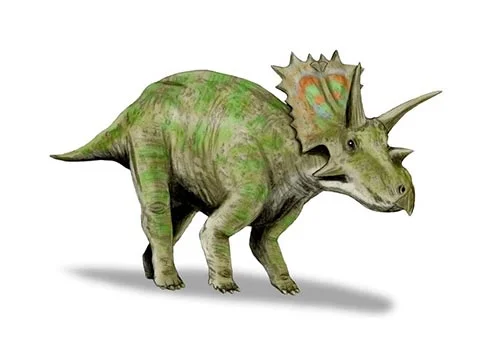Anchiceratops (Near horned face)

An-chi-seh-ra-tops
Barnum Brown - 1914
Herbivore
Estimated from 4-6 meters long
Ceratopsian
A. ornatus (type)
Canada, Alberta - Horseshoe Canyon Formation, Dinosaur Park Formation. USA, Wyoming Almond Formation
Late Cretaceous, 74-70 million years ago
Anchiceratops Facts
Anchiceratops (/,aeNGki’ser@taps) was an extinct genus belonging to the a chasmosaurine ceratopsid dinosaur which lived from 72-71 million years ago in the last part of the Cretaceous Period in what is currently Alberta, Canada.
It was a medium-sized well-built, ground-dwelling quadruple herbivore with two brow horns that were long and one horn that was short in the nasal area. A dozen skulls belonging to the genus were found, including the holotype and two other skulls that were partially carved.
The genus name, Anchiceratops, is derived from Greek terms “anchi” (agkhi-) meaning “near”, “keras” (keras) meaning “horn”, and “ops” (ops) which means “face”. It was identified as a species in 1914 by American paleontologist Barnum Brown.
Anchiceratops fossils are found in the Horseshoe Canyon Formation of Alberta and the Maastrichtian Almond Formation of Wyoming. Additional material has been discovered in sediments of the terrestrial environment of the St. Mary River Formation at the Scabby Butte locality in southwestern Alberta, but they cannot be considered to be belonging to a distinct species. A. ornatus is a quadruple herbivore with 3 horns on the head, a parrot-like beak, and a long frill that extended out from the rear to the top of its head. Its body size is unknown, but Gregory S. Paul estimated its length to be 4.3 meters and its weight as 1.2 tonnes.
Its frills are rectangular in shape and bordered by huge Epoccipitals. The specimen NMC 8547, which is the basis on which descriptions of the postcrania of anchiceratops were based, exhibits numerous characteristics that are distinctive to the Chasmosaurinae, such as epiparietals, bony knobs, parietal fenestrae, and deep arterial grooves.
The vertebral column is composed of seventy-four vertebrae, including ten of the neck, 13 sacrals, twelve dorsals, and thirty nine caudals. The synsacrum is shifting towards the rear, and the neck contains four syncervicals that are fused to the cervical vertebrae anterior.



